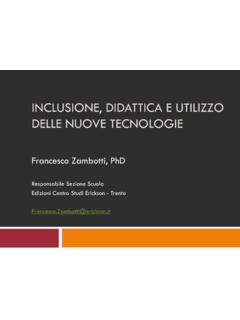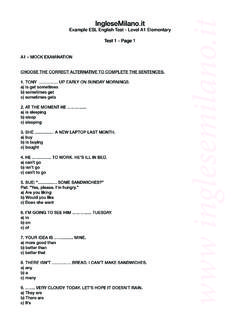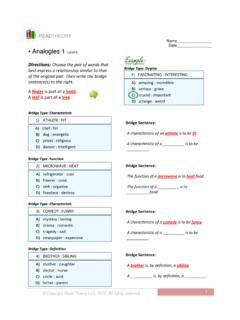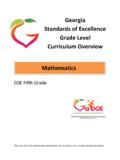Transcription of EAI-Low Level Design Document - unitn.it
1 EAI-Low Level Design Document Version No.: Date: Project Name: Project Code: <Address>. Revision History Version No Date Prepared by / Significant Changes Modified by 1. Glossary Abbreviation Description Page 2 of 13. Table Of Contents 1 Introduction .. 5. Identification .. 5. Glossary of Terms .. 5. Referenced Documents .. 5. 2 Design Overview .. 5. 3 Design Description .. 6. Business Process workflow .. 6. Business Process Modeling and Management (as applicable) .. 6. Interface Design .. 6. Business Logic .. 6. 7. Transformation Rules .. 7. Transformer Classes (as applicable) .. 7. Message / Event Design (as applicable) .. 7. Event/ Message Flow Diagram (as applicable) .. Error! Bookmark not defined. Event / Message Structure (as applicable) .. Error! Bookmark not defined. Transactional Event / Messages (as applicable).. Error! Bookmark not defined. Error / Exceptional Handling.
2 9. Activity / Class Diagrams (as applicable) .. 10. Data Mapping Information .. 11. 4 Configuration .. 11. Adapter / Connector 11. Adapter / Connector 11. Adapter / Connector Details (as applicable).. 11. Application Configuration(as applicable) .. 12. EAI Tool Configuration(as applicable).. 12. Third Party Tool Configuration(as applicable) .. 12. 5 Customization .. 12. Application (as applicable) .. 12. EAI Tool .. 12. 6 Assumptions .. 12. 7 Dependencies .. 12. 8 Cross Reference with SRD / HLD .. 13. Page 3 of 13. 9 Annexures .. 13. Page 4 of 13. 1 Introduction Identification Project Name Document Name Document Version No. Glossary of Terms Referenced Documents 2 Design Overview The Business Process workflow used in our system can be broken down into three tiers:- 1) The Client Tier with the HTML and the messages that are interchanged 2) The middle tier which comprises of service mix and the Server with the business logic 3) The Back end tier with the database.
3 Client tier Middle Tier Data Management Tier Integration Web layer BPM mySQL. HTML Hibernate JSP. Page 5 of 13. 3 Design Description Business Process workflow Our scenario and workflow Design call for our workflow to interface with the following hypothetical and actual components and applications: The WorkFlow client used by the HCS, and Government Employee, and the normal user accessing through the web interface. The Hibernate component that provides database access and update and change of data. Server-side components, such as servlets, in the front-end Web application with which the customer interacts A back-end reporting application An e-mail client to which a confirmation message may be sent A message passing architecture implemented using service-mix Business Process Modeling and Management (as applicable). Interface Design Business Logic Page 6 of 13. Variables Transformation Rules Transformer Classes (as applicable).
4 Message / Event Design (as applicable). To interact, in an asynchronous fashion, with other types of server-side components such as servlets or back-end applications, the Integration workflow shares data via XML documents that are published to queues and received from queues. Thus, to communicate with many of the external and even internal components in our workflows, we will need to compose and send XML messages to either a Worklist client user, or an external or internal topic or queue. XML elements and attributes correspond to workflow variables for which values are provided at run time. We use outgoing XML documents in the sample workflows for the following purposes: To substitute for the XML Document which would be sent by a front-end Web application to trigger the new-individual registration application To request the government to provide the result of the search performed Services search_person: Gov HCS.
5 Input: Query output: set of person_Data Business Logic . Search on the database to get the personal data. Receive the search parameter, send the search result. Used By: Government Clerk Variables . personID. The diagram above demonstrates how to represent in the UML a service that exposes a set of interfaces. By separating the notion of a service which is an actual software entity that exists at some identified end point from the interfaces which are a specification of some set of behavior we gain the flexibility to reuse common interfaces across a Page 7 of 13. number of services. In this way an interface can be defined as a stand-alone entity, versioned and managed independently from any service that implements it (in UML. terms the service realizes the interface). The diagram above demonstrates how the abstract Message structure is used, that the Journal Content Request message is a specialization that includes an element from the Journal Content Domain.
6 As an example, given SOAP and a simple UML XML serialization we could expect to see the following request message in XML. Also note that the constraint {signed} in the model results in the generation of an XML. Soap <env:Envelope xmlns:env=" ">. <env:Header>.. </env:Header>. <env:Body>. <m:SearchRequest xmlns:m=" ">. <m:PersonIdentifier>. <m:Person id>..</m: Person id >. </m:PersonIdentifier>. <sig:Signature xmlns:sig=" #">. </sig:Signature>. </m:JournalContentRequest>. </env:Body>. </env:Envelope>. Deploy WSDL. <deployment xmlns=" ". xmlns:java=" ">. <service name="Searchperson" provider="java:RPC">. <parameter name="className" value=" "/>. <parameter name="allowedMethods" value="*"/>. Page 8 of 13. </service>. </deployment>. Publish service Axis_Lib is the path of . set Axis_Lib=D:\workspace\test\WEB-INF\lib set Java_Cmd=java set Axis_Servlet=http://localhost:8080/test/ servlet/AxisServlet %Java_Cmd% -l%Axis_Servlet% it is important to separate out the structures that define a message passed in orout of a service action and the domain content that is used as the content of the message.
7 The following diagram demonstrates this separation. This allows us to separate information about the instance of a message from the content in the message, so for example the same content might be sent to two different end points but have different associated message- Level information included. This separation also allows the definition of properties that are to be consumed by the HCS- Gov-System aware end-point but not necessarily by the end-user of consumer of the content. This separation also allows us to adhere to a common layered approach to the architecture that clearly defines the content relevant to each layer in a simple model as shown below. Error / Exceptional Handling Page 9 of 13. Activity / Class Diagrams (as applicable). Class Diagram for HCS side Page 10 of 13. Class Diagram for Government side Data Mapping Information 4 Configuration Adapter / Connector Configuration Adapter / Connector Name Adapter / Connector Details (as applicable).
8 Page 11 of 13. Application Configuration(as applicable). EAI Tool Configuration(as applicable). Third Party Tool Configuration(as applicable). 5 Customization Application (as applicable). Serial no Interface Available out-of- Application module to % customization identified the-box in be used required application EAI Tool Serial No Interface Available Out-of- Connector / Adaptor % Customization Identified the-box in EAI to be Used Required Tool 6 Assumptions 7 Dependencies Page 12 of 13. 8 Cross Reference with SRD / HLD. 9 Annexures Page 13 of 13.









